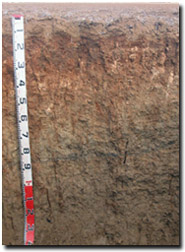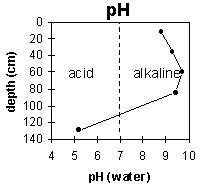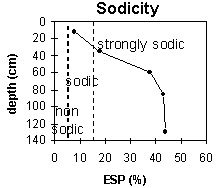ORZC12
| Location: Curyo. | Australian Soil Classification: Vertic (& Epihypersodic), Pedal, Calcic, CALCAROSOL. |
| Geology: Quaternary (Woorinen Formation) overlying Tertiary (Parilla Sandstone) within 2 metres of the surface. | |
| General Landscape Description: Level plain. When the area was first cleared there was evidense of large gilgai microrelief. | |
| Site Description: Demonstration site for the Birchip Cropping Group 2002. | Native Vegetation: Mallee. |
 Site ORZC12 Landscape |
Soil Profile Morphology:
Surface Soil
| Ap | 0-12 cm | Brown (7.5YR4/4); heavy clay loam; soft surface condition; weakly structured; weak consistence (moist); moderately calcareous; pH 8.8; abrupt change to: |  Site ORZC12 Profile |
| Subsoil | |||
| B21 | 12-35 cm | Yellowish red (5YR5/6); light medium clay; weak-moderate very coarse prismatic, parting to moderate-strong coarse to medium blocky structure; some organic staining along ped faces; few (5-10%) soft calcium carbonate segregations; very firm consistence (dry); highly calcareous; pH 9.3; gradual change to: Note: some patches of the B21 horizon are light pinkish brown (7.5YR7/4) with few reddish yellow (5YR6/6) mottles and display strong prismatic structure with a common (10-20%) amount of fine earth carbonate segregations. | |
| B22k | 35-60 cm | Pinkish brown (7.5YR7/4) with yellowish red (5YR5/8) mottles; medium clay; weak-moderate coarse to very coarse prismatic, parting to moderate coarse blocky structure; few (5%) fine earth carbonate segregations; highly calcareous; strong consistence (dry); pH 9.7; gradual change to: | |
| B23 | 60-85 cm | Very pale brown (10YR7/3) with yellowish red (5YR5/6) mottles along root channels; medium clay; weak-moderate coarse prismatic, parting to moderate medium to fine polyhedral structure; trace of fine earth carbonate segregations; flecks of manganese in 70-80 cm zone, mainly down root channels; firm consistence (moderately moist); pH 9.4; non-calcareous; gradual change to: | |
| B3 | 85-130 cm | Very pale brown (10YR7/3); medium heavy clay; possibly coarser prismatic, parting to moderate-strong lenticular structure; weak consistence (moist); pH 5.2. | |
Key Profile Features:
- Gradual increase in clay content down the soil profile.
- Calcium carbonate present in upper subsoil.
- Vertic properties (i.e. lenticular structure) in deeper subsoil.
pH | Salinity Rating | |||
Surface soil (Ap horizon) | Strongly Alkaline | Low | Sodic | None 1 |
Upper subsoil 12-35 cm | Very Strongly Alkaline | Low | Strongly Sodic | None 1 |
Deeper subsoil (at 60-85) | Very Strongly Alkaline | High | Strongly Sodic | Strong |
Deep subsoil (at 85-130 cm) | Strongly Acid | Very High | Strongly Sodic | None 2 |
 |  |  |
 |  |
Horizon | Horizon Depth (cm) | pH (water) | pH (CaCl2) | EC 1:5 | NaCI % | Exchangeable Cations | Boron mg/kg | Field Capacity pF 2.5 | Wilting Point pF 4.2 | Coarse Sand (0.2 - 2 mm) | Fine Sand (0.02 -0.2 mm) | Silt (0.002 -0.02 mm) | Clay (<0.002 mm) | |||
Ca | Mg | K | Na | |||||||||||||
meq/100g | ||||||||||||||||
Ap | 0-12 | 8.8 | 8.1 | 0.28 | 0.01 | 17 | 7.3 | 2 | 2.2 | 4.8 | 44 | 21 | 21 | 23 | 15 | 31 |
B21 | 12-35 | 9.3 | 8.5 | 0.44 | 0.02 | 12 | 11 | 1.3 | 5.2 | 13 | 50 | 30 | 15 | 18 | 10 | 42 |
B22k | 35-60 | 9.7 | 9.5 | 0.93 | 0.09 | 9.7 | 16 | 1.5 | 13 | 54 | 49 | 25 | 13 | 17 | 13 | 4 |
B23 | 60-85 | 9.4 | 9.1 | 1.2 | 0.14 | 3 | 14 | 1.7 | 14 | 41 | 52 | 24 | 12 | 18 | 14 | 49 |
B3 | 85-130 | 5.2 | 4.7 | 1.6 | 0.26 | 2 | 8.3 | 0.9 | 8.6 | 8.2 | 23 | 11 | ||||
Management Considerations:
- The soil profile is mainly strongly alkaline to very strongly alkaline throughout. This indicates that phosphorus and some trace elements such as iron, manganese, copper and zinc may be poorly available to plants. Deficiencies should be determined by plant tissue analysis.
- The surface soil is well suited as a seedbed – the surface condition is soft and the soil has a weak consistence (i.e. it does not become excessively hard). It is, however, quite shallow and should be protected as much as possible from wind and water erosion and over-cultivation. Promoting organic matter levels will be beneficial.
- The high wilting point value (i.e. 21%) indicates that plants will be unable to fully utilise light rains when the soil is relatively dry.
- The surface soil is sodic and disperses strongly after remoulding. This indicates that structural degradation (e.g. surface sealing, crusting, increased cloddiness) may occur if the soil is cultivated or overstocked in a moist to wet condition. Also, raindrop action on bare surface soil may also promote dispersion and result in surface sealing or surface crust formation. Surface cover should be maintained to protect against raindrop damage. The use of gypsum may also assist in ameliorating the surface soil. Management practices such as minimum tillage, stubble retention and pasture rotation can be used to improve organic matter levels.
- The subsoil is strongly sodic throughout and dispersive, with a low calcium to magnesium ratio. The upper subsoil disperses strongly after remoulding, which indicates that disturbance to this horizon during tillage, when the soil is in a moist to wet condition, will result in structural degradation occurring. If tillage is to take place then the soil should be drier than the plastic limit to at least the depth of tillage.
- Boron toxicity can also occur in strongly alkaline soils. The boron levels measured in the deeper very strongly alkaline subsoil (i.e. at 35 cm depth) are quite high and may affect boron-sensitive species (including cereals, pulses, pasture legumes). Concentrations as low as 10 ppm, for example, can reduce lentil yield. Limited data estimates that the threshold level of soluble boron for cereals is 15 mg/kg (Cartwright et al., 1984). Other work at VIDA indicates that where there are low levels of soluble salts, that boron tolerance can be comparatively high, with little reduction in wheat yield at levels of up to 45 ppm (Quinlan, 2001).
- The subsoil below 35 cm depth is strongly sodic and disperses strongly. This is likely to significantly restrict root and water movement into the subsoil. The high level of exchangeable sodium in the subsoil may also result in nutrient imbalances and may even have a toxic effect on some plants.
- The level of soluble salts becomes high in the deeper subsoil. At these levels, the growth of salt-sensitive species (e.g. faba beans, linseed, chick peas, lupins) may be restricted.
Profile Described By: Mark Imhof, Paul Rampant and Steve Ryan (2002).
References
Cartwright, B., Zarcinas, B.A, and Mayfield, A.H. (1984). Toxic Concentrations of Boron in a Red-Brown Earth at Gladstone, South Australia. Australian Journal of Soil Research. 22. 261-72.
Hobson, K. (2001). Boron Tolerant Lentils. In On The Pulse pamphlet. NRE. 2001.
Maschmedt, D. (2000). Agricultural Land Classification Standards used in South Australia’s Land Resource Mapping Program. Department of Primary Industries South Australia.
Quinlan, J. (2001). Sorting out the Boron Problem. Wimmera Farming & Landcare Newsletter. 19-20.
Rengasamy, P. and Churchman, G.J. (1999). Cation Exchange Capacity, Exchangeable Cations and Sodicity. In: Soil Analysis – An Interpretation Manual. (eds. Peverill, K.I et al). CSIRO Publishing.
White, P.F. (1990). Soil and Plant Factors Relating to the Poor Growth of Lupinus species on Fine Textured Soils – A Review. Australian Journal of Agricultural Research 41: 871-890.


